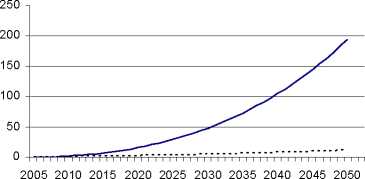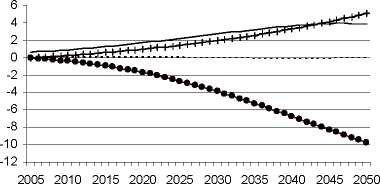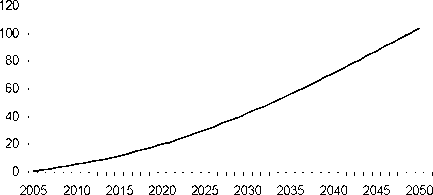Table 2:
Baseline Scenario: Keeping Generosity of PAYG
|
2004 |
2010 |
2020 |
2030 |
2040 |
2050 | |
|
GDP per capita |
1.7 |
1.7 |
1.6 |
1.5 |
1.3 |
1.2 |
|
Private Investment/GDP |
15.5 |
16.5 |
18.1 |
19.3 |
19.3 |
19.0 |
|
Unemployment Rate |
8.1 |
8.3 |
9.0 |
10.0 |
11.3 |
12.8 |
|
Real Interest Rate |
4.9 |
4.6 |
4.0 |
3.4 |
3.0 |
2.9 |
|
Retiree Cons ./Worker Cons. |
1.8 |
1.7 |
1.7 |
1.6 |
1.6 |
1.6 |
|
Pension/GDP |
9.7 |
10.3 |
11.6 |
13.3 |
15.4 |
17.3 |
|
Social Security Contributions |
14.9 |
15.8 |
17.8 |
20.4 |
23.5 |
26.5 |
GDP per capita: % deviation from baseline levels. The remaining figures are percentage point deviations
from baseline levels.
4.2. Scenario 1: Debt financing of additional pension spending after 2005
The government guarantees the 2005 pension replacement rate and at the same time freezes the
pension contribution to the current level. The difference between contributions and actual pension
expenditure is financed via an increase in government debt. With a constant contribution rate (of
currently 16%) the share of pensions covered by the PAYG contribution would decline from 100%
to about 66% in 2050. In other words the pension contributions of workers would only finance a
replacement rate of about 50% in 2050. After 2050 debt accumulation is stopped via an increase in
lump sum taxes. As shown in figure 3, debt is on an explosive and clearly unsustainable path.
Debt and Deficit to GDP Ratio

------Debt to GDP ratio .......Deficit to GDP ratio
Figure 3 Debt Financing of additional Pensions
Employment, GDP, Consumption and Capital

—I—Employment .......GDP -----Consumption ∙ Capitall
Real Interest Rate

84
More intriguing information
1. Personal Experience: A Most Vicious and Limited Circle!? On the Role of Entrepreneurial Experience for Firm Survival2. The name is absent
3. Informal Labour and Credit Markets: A Survey.
4. The name is absent
5. Innovation in commercialization of pelagic fish: the example of "Srdela Snack" Franchise
6. The name is absent
7. Education Research Gender, Education and Development - A Partially Annotated and Selective Bibliography
8. The name is absent
9. Word Sense Disambiguation by Web Mining for Word Co-occurrence Probabilities
10. he Virtual Playground: an Educational Virtual Reality Environment for Evaluating Interactivity and Conceptual Learning